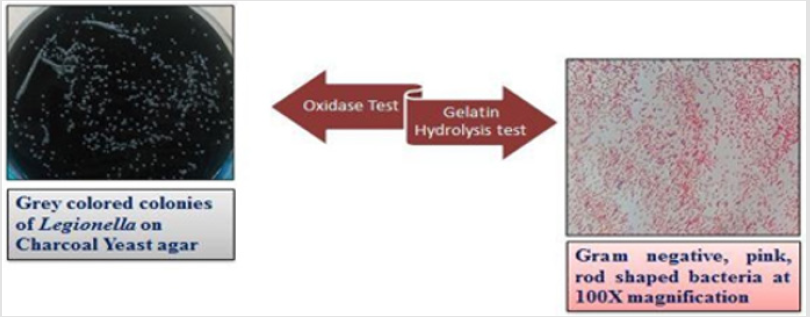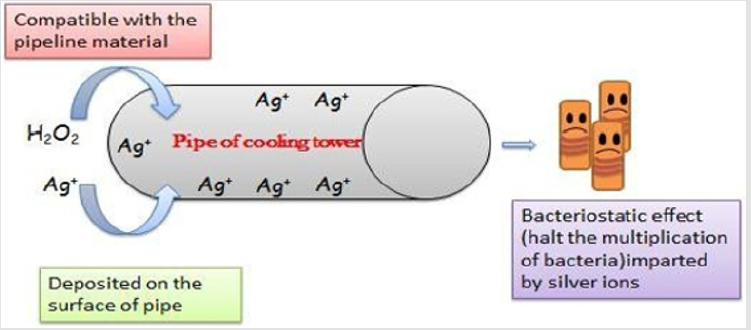Abstract
Legionella are gram negative, opportunistic pathogenic bacteria, common to freshwater environment. These bacteria are the causative agent of Legionnaires disease, a serve form of pneumonia that primarily occur in case of smokers, person with chronic lung disease or immune-compromised. The mode of transmission of disease is inhalation of contaminated aerosols from water systems such as cooling towers. Cooling towers are a foremost cause of Legionnaire’s disease. This review follows the detection strategies of Legionella species in cooling tower water and risk assessment associated with the disease. This study can be used to improve the water quality in order to minimize the disease outbreak and potentially improves the public health.
Keywords: Legionella; Cooling Towers; Legionnaire’s Disease
Introduction
Legionella is aerobic, waterborne and non-motile opportunistic bacterial species. The Legionella bacterium was first identified in 1976 during the annual convention of the American Legion in Philadelphia. The infection of Legionella is mainly spread through inhalation of contaminated aerosols generated during the functioning of cooling towers [1]. Cooling towers are a part of the air-conditioning systems often present in large buildings, such as cooling towers or hospitals, which use water to efficiently cool air via heat transfer. Due to the presence of sediments, nutrients in water it further flourishes the environmental microbes [2,3]. Majorly Legionella species occur in untreated water which is warm and where it is possible for it to become aerosolized or misted. Legionella species grow best between temperatures of 72°F and 113°F (22°C-45°C) with optimum growth temperature being 95°F and 104°F (35°C-40°C) [4].
In US, the leading cause of deaths from waterborne outbreaks is Legionella [5]. From past 14 years in US, there are 4-fold increases in the instances of Legionnaires’ disease [6,7] that is a public health threat. Symptoms are range from flu-like to multisystem organ failure. Approximately half of distinguished Legionella species have been appeared to cause the disease, majorly reported cases of disease was caused by Legionella pneumophila serogroup [8]. Legionnaires’ disease is caused by pathogenic Legionella pneumophila belongs to Legionellaceae family. The Legionella ceae comprises of more than 42 species. L. pneumophila is the most common species, and it causes 90% of the cases of Legionellosis, followed by other species viz L. micdadei, L. bozemanii, L. dumoffii, and L. longbeachae. Around fifteen serogroups of L. pneumophila have been identified, with serogroups 1, 4, and 6 identified as the causes of human disease. The serogroup 1 is thought to be responsible for 80% of the reported cases [9].
The investigation of Legionnaires’ disease outbreaks associated with cooling towers have revealed inadequately maintained systems, poor sterilization and lack of control measures. To regulate the count of pathogenic species, regular maintenance of cooling towers (prevention of biofouling, scale, salt deposition) are recommended. Further measures include monthly cleaning of internal parts (heat exchanger) of cooling towers in order to eliminate dust, dissolved solids and organic material. According to the report of Mouchtouri et al. [10], an incredible number of the cooling towers did not have a hazard assessment and the executives plan set up, an operational manual, or standardized cleaning and maintenance methodology which clearly indicate that the operation of cooling towers was not being steadily examined.
Detection of Pathogenic Species
The preliminary detection of Legionella, in the water sample can be performed by plating the water dilutions (KCl: HCl) onto charcoal yeast extract agar which was supplemented with L-cysteine to inhibit the growth of unwanted microbes Figure 1. Further, oxidase and gelatin hydrolysis (due to the presence of gelatinase enzyme) test confirmed the presence of Legionella. Highthroughput 16s rRNA amplicon sequencing facilitated the research into micro-biomes of natural or built environment [11]. Though, the reports on micro-biomes of these systems are limited and primarily related to potable water [12,13]. A study was reported on micro-biomes of cooling tower in Germany that revealed a diverse bacterial community of Legionella abundantly found in arrange of 0.06-6.0% [14-16].
Risk Identification
Globally, Legionella pneumophila is the most widely recognized causative agent of Legionellosis [17]. Recently, worldwide increase in the incidence of Legionellosis was reported [18]. In 2011, there were 4897 confirmed cases of Legionellosis in Europe [19] and 4202 cases in US [20]. In 2013, Australia recorded 2.2 cases of Legionellosis per 100,000 [21]. Risk identification is the main factor of the risk assessment framework, for Legionella this is restricted as the true incidence of Legionellosis is obscure and it has been estimated that the occurrence of Legionellosis could be 20 times greater than the currently reported incidence [22].
Treatment Through Disinfectant
Hydrogen peroxide has numerous advantages over chlorine as an oxidizing biocide: it is compatible with various pipeline materials, and it does not react with the organic constituents in the water to form chlorine. However, at a persistent feed rate of approximately 2.5 mg/L, it was unable to control the planktonic population [23], and the silver can be deposited on the piping system, promoting a bacteriostatic effect depicted in Figure 2. As described by various researchers, H2O2 decomposes rapidly in different environmental conditions due to microbial catalase and peroxidase, and other than abiotic action, the decomposition is promoted by heavy metal, oxidative, and reductive reactions. The H2O2/Ag+ formulation is stable in high temperatures and its disinfection power increases significantly as the water temperature increases. The above formulation successfully controlled Legionella in hot water systems where temperature ranging from 40-50ºC [24].
Case Study
In the month of July to august 2015, an enormous outbreak of Legionnaires’ disease was reported in South Bronx NYC. A total of 138 cases and 16 deaths were reported by the researcher [25]. The average age of the patients acquired disease was around 55 years and 62% were male. Authorities traced that the outbreak was due to the cooling tower of Opera House Hotel. The strains of Legionella found in the cooling tower of hotel were matched with the strain found in the patients. In October, 21 cooling towers shows the presence of Legionella in other areas in the South Bronx. Due to the outbreak, city government mandated the cleaning and disinfection of South Bronx cooling towers [26]. Another case study of multiple Legionnaires’ disease outbreaks in Sydney (2016) was obtained from NSW Health [27]. There were numerous outbreaks identified in other locations of Sydney [28].
Conclusion
The present study marked the presence of L. pneumophila in the water-based cooling towers which may lead to nosocomial Legionellosis outbreak. The detection procedure, risk assessment and treatment (H2O2/Ag+ formulation) were briefed in the investigation.
Acknowledgement
We are thankful to the Director General, TERI (The Energy and Resources Institute) for providing the infrastructural facilities to execute the primarily analysis of the study.
References
- Mercante JW, Winchell JM (2015) Current and emerging Legionella diagnostics for laboratory and
- outbreak investigations. Clin microbiol rev 28(1): 95-133.
- Yamamoto H, Sugiura M, Kusunoki S, Ezaki T, Ikedo M, et al. (1992) Factors stimulating propagation of legionellae in cooling tower water. Appl environ microbiol 58(4): 1394-1397.
- Mouchtouri VA, Goutziana G, Kremastinou J, Hadjichristodoulou C (2010) Legionella species colonization in cooling towers: risk factors and assessment of control measures. Am J infect control 38(1): 50-55.
- Legionella Treatment.
- Hilborn ED, Wade TJ, Hicks L, Garrison L, Carpenter J, et al. (2013) Surveillance for waterborne disease outbreaks associated with drinking water and other nonrecreational water-United States, 2009–2010. MMWR 62(35): 714-720.
- Adams D, Fullerton K, Jajosky R, Sharp P, Onweh D, et al. (2015) Summary of notifiable infectious diseases and conditions-United States, 2013. MMWR Morb mortal wkly rep 62(53): 1-122.
- CDC (2015) Notice to readers: Final 2014 reports of nationally notifiable infectious diseases. MMWR
- Morb mortal wkly rep 64(36): 1019-1033.
- Burillo A, Pedro-Botet ML, Bouza E (2017) Microbiology and epidemiology of legionnaire's disease.
- Infect dis clin North Am 31(1): 7-27.
- Brady MF, Sundareshan V (2018) Legionnaire’s disease (Legionella Infection) [Updated 2018 Oct 27].
- In: StatPearls [Internet]. Treasure Island (FL): Stat Pearls Publishing.
- Palmer A, Painter J, Hassler H, Richards VP, Bruce T, et al. (2016) Legionella clemsonensis sp. nov.: A green fluorescing Legionella strain from a patient with pneumonia. Microbiol immunol 60(10): 694-701.
- Leung MH, Lee PK (2016) The roles of the outdoors and occupants in contributing to a potential
- pan-microbiome of the built environment: A review. Microbiome 4(1): 21.
- Baron JL, Vikram A, Duda S, Stout JE, Bibby K (2014) Shift in the microbial ecology of a hospital hot water system following the introduction of an on-site monochloramine disinfection system. Plos one 9(7): e102679.
- Feazel LM, Baumgartner LK, Peterson KL, Frank DN, Harris JK, et al. (2009) Opportunistic pathogens enriched in showerhead biofilms. Proce National Academy of Sci United State Am106(38): 16393-16399.
- Wery N, Bru-Adan V, Minervini C, Delgenes JP, Garrelly L, et al. (2008) Dynamics of Legionella spp. and bacterial populations during the proliferation of pneumophila in a cooling tower facility. App environ microbiol 74(10): 3030-3037.
- Sharmin F, Wakelin S, Huygens F, Hargreaves M (2013) Firmicutes dominate the bacterial taxa within
- sugar-cane processing plants. Scientific reports 3: 3107.
- Pereira RPA, Peplies J, Hofle MG, Brettar I (2017) Bacterial community dynamics in a cooling tower with emphasis on pathogenic bacteria and Legionella species using universal and genus-specific deep sequencing. Water Res 122: 363-376.
- Buchbinder S, Trebesius K, Heesemann J (2002) Evaluation of detection of Legionella spp. in water samples by fluorescence in situ hybridization, PCR amplification and bacterial culture. Int J Med Microbiol 292: 241-245.
- (2011) Centers for Disease Control and Prevention. Legionellosis-United States, 2000-2009. Morb Mortal Wkly Rep 60: 1083-1086.
- (2013) European Centre for Disease Prevention and Control. Legionnaire’s Disease Surveillance in Europe, 2011. Stockholm: ECDC.
- Adams DA, Gallagher KM, Jajosky RA, Kriseman J, Sharp P, et al. (2013) Centers for Disease Control and Prevention. Summary of notifiable diseases-United States, 2011. MMWR Morb Mortal Wkly Rep 60(53): 1-117.
- (2014) Department of Health. Australia’s National Notifiable Diseases Surveillance System (NNDSS). Canberra, ACT: Australian Government.
- Harriet W, Alexandra K, Howard F, Kirstin R (2004) Uncertainties associated with assessing the public health risk from Legionella. Front Microbiol 5.
- Casini B, Aquino F, Totaro M, Miccoli M, Galli I, et al. (2017) Application of hydrogen peroxide as an innovative method of treatment for Legionella control in a hospital water network. Pathogens 6(2):pii: 15.
- Moosavian M, Dashti A (2011) Isolation and identification of Legionellosis agents from fishponds,swimming pools and cooling towers in Khuzestan province, Iran. Jundishapur J Microbiol 4: 209-216.
- Weiss D, Boyd C, Rakeman JL, Greene SK, Fitzhenry R, et al. (2017) a large community outbreak of legionnaires' disease associated with a cooling tower in New York City, 2015. Public Health Rep 132(2): 241-250.
- (2015) NYC Health. Fact sheet: Legionnaires’ disease in the South Bronx.
- (2016) NSW Health. Public Health investigation into the legionella outbreaks in Sydney CBD.
- (2016) NSW Health. Legionella outbreaks2016- A detailed overview.

 Mini Review
Mini Review

